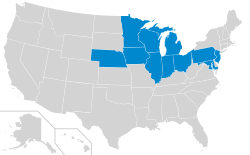Big Ten
| Big Ten Conference (B1G) |
|
|---|---|
 |
|
| Established | 1896 |
| Association | NCAA |
| Division | Division I FBS |
| Members | 14 + 2 affiliate members |
| Sports fielded | 28 (men's: 14; women's: 14) |
| Region | |
| Former names | Intercollegiate Conference of Faculty Representatives (officially, 1896 – 1987) Western Conference (1896 – 1899) Big Nine (1899 – 1917, 1946 – 1949) |
| Headquarters | Rosemont, Illinois |
| Commissioner | James Delany (since 1989) |
| Website | www |
| Locations | |
 |
|
The Big Ten Conference (B1G), formerly Western Conference and Big Nine Conference, is the oldest Division I collegiate athletic conference in the United States. The conference, consisting of 14 members as of 2016, competes in the NCAA Division I; its football teams compete in the Football Bowl Subdivision (FBS), formerly known as Division I-A, the highest level of NCAA competition in that sport. The conference includes the flagship public university in each of 11 states stretching from New Jersey to Nebraska, as well as two additional public land grant schools and a private university.
The Big Ten Conference was established in 1895 when Purdue University president James H. Smart and representatives from the University of Chicago, University of Illinois, University of Michigan, University of Minnesota, Northwestern University, and University of Wisconsin gathered at Chicago's Palmer House Hotel to set policies aimed at regulating intercollegiate athletics. In 1905, the conference was officially incorporated as the "Intercollegiate Conference Athletic Association".
Big Ten member institutions are predominantly major flagship research universities with large financial endowments and strong academic reputations. Large student enrollment is also a hallmark of Big Ten universities, as 12 of the 14 members feature enrollments of 30,000 or more students. Northwestern University, one of just two full members with a total enrollment of fewer than 30,000 students (the other is the University of Nebraska–Lincoln), is the lone private university among Big Ten membership (the University of Chicago, a private university, left the conference in 1946). Collectively, Big Ten universities educate more than 520,000 total students and have 5.7 million living alumni. Big Ten universities engage in $9.3 billion in funded research each year. Though the Big Ten existed for nearly a century as an assemblage of universities located primarily in the Midwest, the conference's geographic footprint now spans from the state of Nebraska in the west to the Atlantic Ocean in the east.
...
Wikipedia
